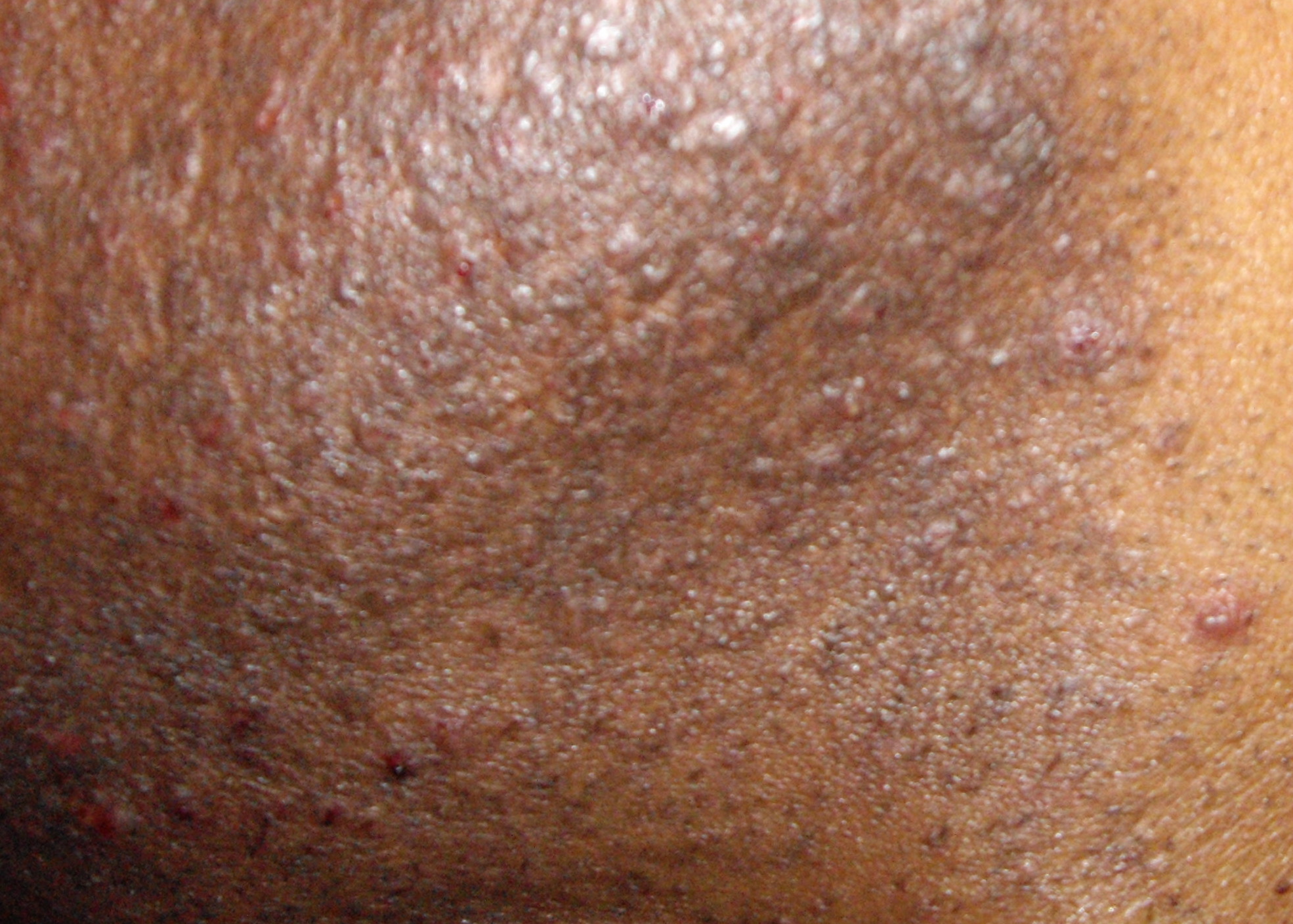- Home
- Shaving Bumps/Razor Bumps
Shaving Bumps/Razor Bumps
About Shaving Bumps/Razor Bumps
Shaving Bumps, also referred to as ingrown hairs [or more appropriately referred to as "entrapped hairs"], pseudofolliculitis barbae or pfb, plague over 10 million African American men in the USA and over 300 million men of color worldwide.
 Shaving bumps, including the very difficult to treat "back of the head bumps", represent a very significant issue for men of color worldwide. Some have seen limitations in their careers as well as major social set backs due to their inability to get smooth shaves. Many have reluctantly given up shaving altogether.
Shaving bumps, including the very difficult to treat "back of the head bumps", represent a very significant issue for men of color worldwide. Some have seen limitations in their careers as well as major social set backs due to their inability to get smooth shaves. Many have reluctantly given up shaving altogether.
Shaving Bumps and ingrown hairs [or more appropriately referred to as "entrapped hairs"] also plague over 100 million men and women from other ethnic groups worldwide.
For men the face is red, irritated and covered with bumps. In women there are bumps and redness in the bikini line area, legs, underarms and face.
BREEJ Technologies disagrees with the widely held view that Shaving Bumps are caused by "in-grown" hairs - wiry, curly hairs that curl and grow back into the skin." This concept of "in-grown" hairs has led to a lot of poking & probing of the shaved area with tweezers often further aggravating the problem. BREEJ discourages this practice as the additional trauma can lead to infection, hyper pigmentation and significant skin damage.
BREEJ asserts that "Shaving Bumps are Primarily caused by Trauma from Shaving, resulting in inflammation of the shaved area manifested as "bumps" as the body reacts to the trauma, compounded at times by Bacterial/Fungal Infections. Induction of Melanogenesis by irritated keratinocytes during shaving, produces additional inflammatory mediators exacerbating the condition [this is the main reason why men of color with higher levels of melanin, have a higher incidence of shaving bumps]"
What Are Ingrown Hairs/Entrapped Hairs and How are they Caused?
BREEJ further explains that "Ingrown hairs [or more appropriately "entrapped hairs"] result when existing shaving bumps block the opening of the hair follicles on the skin forcing the normally growing hairs to "grow into [hence the name "ingrown hairs"] the existing bumps".
Shaving Bumps precede ingrown hairs and as such ingrown hairs are Not the cause of shaving bumps.
WHAT IS THE BEST WAY TO GET RID OF SHAVING/RAZOR BUMPS?
Use a good Anti-Bump Product or Kit [formulated with powerful anti inflammatories, anti bacterials, anti fungals and skin conditioners such as:
For Men
BUMP ZAPPER Severe Bumps Kit
BUMP TERMINATOR Severe Bump Lotion
BUMP TERMINATOR Extra Strength Severe Bump Lotion
For Women
BUMP TERMINATOR Alcohol Free Anti Bump Serum For Women
BUMP TERMINATOR Anti-Razor Bump Serum For Women
Once the razor bumps ore eliminated, the ingrown [entrapped] hairs are freed and can be shaved off easily
SHOULD I SHAVE IF I HAVE RAZOR BUMPS [SHAVING BUMPS; INGROWN HAIRS]?
No – You must first resolve existing Razor Bumps [Shaving Bumps; Ingrown hairs] prior to resumption of shaving
Shaving over existing bumps [especially with classic razors] will only worsen the condition
HOW SHOULD I GET RID OF DAMAGED/DARKENED SKIN CAUSED BY SHAVING BUMPS?
Use a good Skin Repair And Brightening Cream Product [formulated with powerful skin repair agents, skin brighteners and skin conditioners to resolve damaged/darkened skin such as the Bump Zapper Skin Repair And Brightening Cream
HOW SHOULD I ENSURE THAT RAZOR BUMPS [INGROWN HAIRS DO NOT COME BACK]?
Use a good Post Shave Lotion or Serum [formulated with powerful anti inflammatories, anti bacterials, anti fungals and skin conditioners such as the Bump Zapper Anti Bump Soothing Aftershave Lotion to soothe and condition shaved skin
Products on this website have not been evaluated by the FDA and are not intended to diagnose, treat, cure or prevent any disease. Results in description are illustrative and may not be typical and individual results may vary. Description regarding efficacy and safety have not been scientifically substantiated or evaluated by the Food and Drug Administration.
 Loading... Please wait...
Loading... Please wait...
